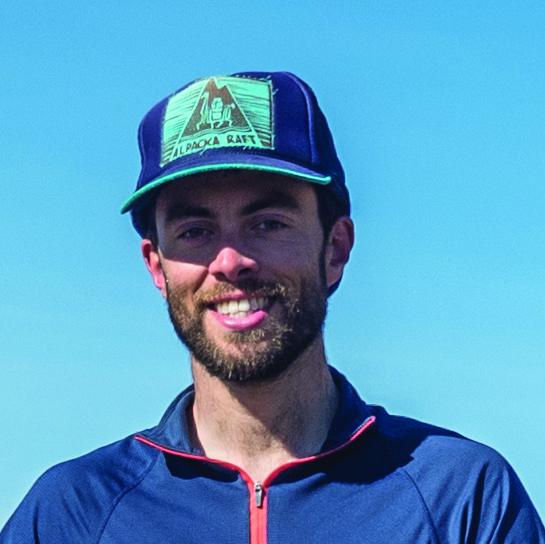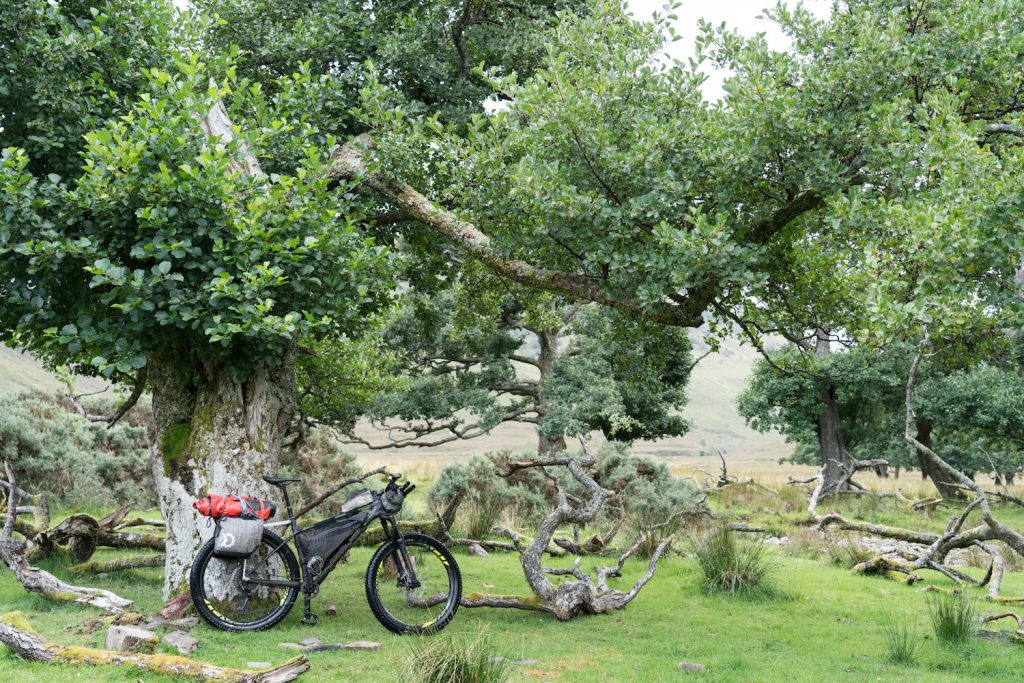Bikerafting: The 1st Questions You Should Ask Yourself (& Others)
PART 1
By Lizzy Scully & Steve Fassbinder

Liz Sampey – Learning from the Pros
When pro endurance athlete and owner of Vital Motion Coaching, Eliza “Liz” Sampey started bikerafting she immediately sought out more experienced packrafters to teach her the skills she needed; she’d never even paddled a canoe or kayak on flatwater! Upon brainstorming her Pakistan and India bikerafting adventure, she recruited a Class V boater to help her run the two-person packraft. She was a stronger cyclist; he packrafter.
She also seeks instruction. A few months before doing her very first bikeraft trip in Alaska, she hired a packraft-specific instructor to teach her how to paddle, read rivers, and in general take care of herself on Alaska’s cold waterways. Liz gained some of her most valuable learning skills from a Swiftwater Rescue certification course taught by a packraft instructor.
“Packraft-specific courses teach you so much more that’s specific to packrafting,” she explains. “Kayakers don’t teach you to self rescue, because they don’t self rescue; they go to shore and have someone rescue their boat. When a packrafter flips and swims, it’s easy to self rescue if you know how to do it and you practice a lot.” While the book is a great resource, she adds, make an effort to go out with people who have done it before or even people who are just getting started so you can bounce ideas and practice in ways that are safe. As she wisely says: “I don’t feel safe going on a river by myself.”


Backcountry Scot’s Andy Toop – Learning the Hard Way
But, says Andy Toop, Scotland’s premier bikeraft instructor, don’t just seek a certificate and think you’re good to go. He cites some instructors offering full expedition courses. “Generally it’s packraft beginners who book on, and they get a certificate to say they’re packraft expedition leaders now…” he says. “I think it’s quite dangerous for them to say, ‘I have my badge,’ and then they go do things without that experience and time that comes from going and trying and doing.”
So, in addition to taking courses, he recommends practicing in a simple, familiar environment. “Make sure that you’re dialied with each element separately before you bring them together. You need to be comfortable with a boat in a wild place and with a bike in a wild place. And then there’s the third dimension of camping.” People do not gain the experience you need overnight, so be patient, he adds.
“You definitely need to be unconsciously competent with both bicycles and packrafts before you put them together and become consciouly incompetent at it,” he says with a laugh. But seriously, bikerafting is hard (because of the extra equipment kit you have to carry, the exploratory nature of the terrain, among other things), and the learning curve is steep. When you think you’ve got it dialed, you’ll get something wrong next time you transition because something different has happened.
“You’ll wonder: ‘Why does my boat keep falling out? And why does it now want to rub on my front tire?’” he says. One has to has that problem solving mind around it all constantly. “The freedom of bikerafting is really good, but you’ve got to be really good to enjoy that freedom because it’s so flexible and dynamic. There are so many little things to consider, and then you throw in the fact that you’re traveling through unknown areas.”

Huw Oliver & Annie Lloyd-Evans – Finding Balance
One of Andy’s numerous proteges, Huw Oliver, agrees that finding friends, practicing and critical thinking are all key to bikerafting.
“Don’t be shy,” Huw says. “Find someone who knows more than you and tell them, ‘we’re going to be friends now.’ Don’t be worried about not knowing enough or looking silly. You’ll save yourself so much effort and also have way more fun and grow the community.” And, he adds, prepare for the worst!
Huw and partner, Annie Lloyd-Evans, practiced self rescuing and righting their boats numerous times in a safe, flat water environment before going into the backcountry.
“Annie and I are both pretty risk averse. Because we work as outdoor instructors, our job is to constantly assess risk and to be aware of the risks your clients don’t know about and to make decisions to keep them safe. As a guide or instructor, we’re always hoping for the best and planning for the worst. We need to be really tuned into what can go wrong and be able to have an answer.”
Be sure to take your own advice
On the other hand, Huw admits he didn’t take his own advice initially when embarking on his first bikeraft adventure, a four-day trip Andy helped him lay out to Knoydart on the northwest coast of Scotland, which some people say is “Europe’s last wilderness.” The riding is steep, the terrain rugged, the boating dangerous, and the one village where you resupply can only be reached by boat.
“My first day I got all packed up and was trying to strap my bike on my boat… it was so much harder than I thought it would be. I would think I was finished, and it would immediately flip itself. The four days were really tough, but they did help me remember.”
It’s important to find a balance. Luckily for Huw, he had significant backcountry experience already as an outdoor educator, mountain biking and bikepacking guide and he had practiced packrafting with Andy. Still, he doesn’t recommend newbies do as he did. Start simple, as Andy reminds.
“Packrafts and bikes can take you to amazing places, but you have to be so careful and make really good choices,” Huw explains. And, to make good choices you need experience. “You have to get stuff wrong to learn lessons.”
This is the first of two excerpts we are publishing from Chapter 21 of the how-to section of The Bikeraft Guide. In it Doom addresses various questions related to getting started as a brand new bikerafter.
Q&A, Part 1
How to hone your bikerafting skills?
- First, use this book and learn from it. It’s designed to provide you with a framework on which to build skills and experience. Then, get out there and acquire the skills needed to be proficient at both bikepacking and packrafting by learning from mentors, teachers and friends with experience. Then go back to the book and review it again, and regularly use it as a reference tool.
- Then, read Luc Mehl’s, “Packraft Handbook.” Follow that with a swiftwater rescue training course with a packraft instructor and/or hire a guide who can teach you bikeraft and packraft specific safety skills.
- Then practice, practice, practice. Beginners need plenty of hands-on experience to actualize what they learn. Make friends with the people in your classes or with whom you’ve done a guided trip, and get out there and practice as much as possible.
Where should people start?
Start in a safe and familiar environment on easy, familiar terrain. You should know both the bike route and body of water you’re packrafting. Take more time than you expect on your first adventures; you’ll be surprised how time consuming it is to transform from bikepacking to packrafting.
And, before you try bikerafting, become really familiar with your boat without a bike on it. Get experience on the flat water bodies and/or river corridors on which you want to try bikerafting. Even flatwater can be dangerous. Several people died in recent years due to a lack of experience crossing large bodies of flatwater. The winds kicked up, and they were in cold water and they lost contact with their boat and couldn’t self rescue. Just because you’re on a lake doesn’t mean you’re safe. And just because you think you can get across it in a few minutes, doesn’t necessarily mean that’s going to happen. The wind is a huge factor, and it is not something to be taken lightly.
How do you determine what type of trip you should take?
Well, you can read this book and get some beta to help you make a decision. But first, determine what level you want to get into. Reach out to other people who have done this type of stuff and share with them your skill level. Then, ask them what kind of trips they’ve done that might be similar, or just propose a trip to someone you know is more experienced, but might be interested in doing a trip with you. Lean on people who have more experience and ask them: “Hey, I’m thinking about doing this. What do you think?” And if you trust or are friends with that person, they will tell you what they think. And then they’ll be honest about their answer. They may warn you or they might be like: “Yeah, get after it, go for it. Dive in.”
FCG Courses & More
Interested in taking a bikerafting course? Check out our events schedule page for more information.
- April 15-17: 3-Day Intermediate Expedition Bikeraft DOOM Course
- April 27-May 1: 5-Day Intensive Intermediate River Bikerafting Course
- May 14-16: 2.5-Day Learn to Bikeraft on the Colorado River Course in the Glen Canyon National Recreation Area
- June 17-19: 3-Day River Bikerafting for Beginners on the
- July 9-11: Summer Special – 3-Day Learn to Bikeraft McPhee Reservoir
Are you in Europe? Visit BackcountryScot.com for a list of courses taught by Andy, Huw and Annie.


